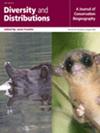Improving Species Distribution Models for Stream Networks by Incorporating Spatial Autocorrelation in Multi-Sourced Datasets: A Range-Wide Assessment of Idaho Giant Salamander Status and Future Risk
Abstract
Aim
Fundamental to species conservation efforts is the development of accurate distribution models. Doing so is challenging for many stream organisms, where limited funding may necessitate the compilation of incidental observations from multiple sources which lack an overall sampling design and are often spatially clustered. We demonstrate the application of specialised spatial-stream-network models (SSNMs), which incorporate autocorrelation among observations and have the potential to improve species distribution models for many organisms.
Location
Rocky Mountains in west-central North America.
Methods
We compiled a comprehensive presence-absence dataset for Idaho giant salamander (IGS; Dicamptodon aterrimus) from previous studies, natural resource agencies, museum collections and new surveys, and linked these data to geospatial habitat covariates. The dataset was modelled using a suite of candidate SSNMs, and results were compared to those from non-spatial generalised linear models (GLMs). The top-ranked models were used to predict range-wide IGS occurrence probabilities for scenarios that represented historical baselines and futures associated with two model covariates (water temperature and riparian tree canopy density) that are changing with environmental trends in the study area.
Results
The classification accuracy of salamander observations was higher with SSNMs than GLMs (90.8% vs. 63.2%) and the spatial models identified fewer significant habitat relationships, which simplified model interpretation. Baseline range estimates from the models were similar (13,090–14,114 stream km) and both predicted small range expansions (2.0%–24.8%) with future warming because many streams were sub-optimally cold for IGS. However, these expansions were partially offset in scenarios which included decreases in riparian canopy density.
Main Conclusions
SSNMs significantly improved species distribution models on stream networks by incorporating spatial autocorrelation and provide an inexpensive means of developing new information from many existing datasets. This incentivises aggregation of datasets, which could be further leveraged to create efficient monitoring and inventory programs using the spatially explicit outputs from SSNMs.


 求助内容:
求助内容: 应助结果提醒方式:
应助结果提醒方式:


